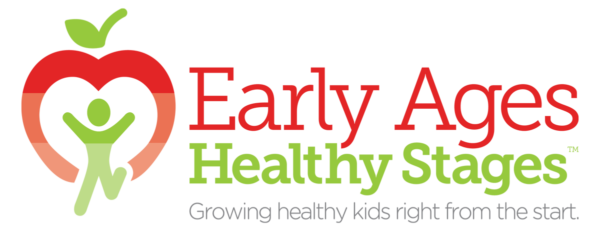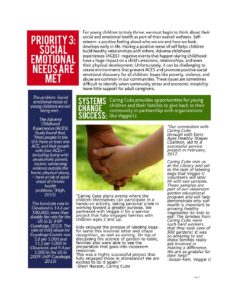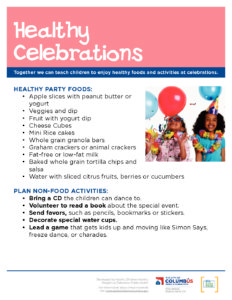Social Emotional Health
For young children to truly thrive, we must begin to think about their social and emotional health as part of their overall wellness. While it’s important that children have healthy bodies on the outside, it’s also important that children feel good in their bodies on the inside. Self-esteem-a positive feeling about who we are and how we look- develops by the time children reach kindergarten. Having a positive sense of self also helps children build healthy relationships with others.
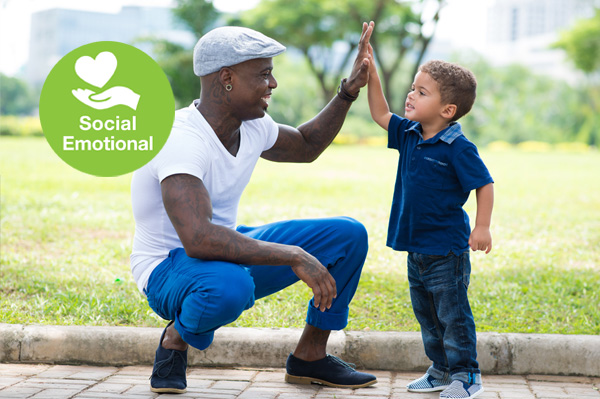
Adverse childhood experiences (ACES)-negative events that happen during early childhood- have a huge impact on a child’s emotions, relationships, and even their physical development. In Cuyahoga County, we have many excellent programs to identify and treat children with ACES and other social and emotional needs. Unfortunately, it can be challenging to create environments that prevent ACES and promote positive social emotional discovery for all children. Issues like poverty, violence, and abuse are common in our communities. These issues are sometimes difficult to identify when community stressors and economic instability leave little support for adult caregivers.
Social Emotional Health | Our Goal:
Early Ages Healthy Stage Coalition will work with community partners to increase awareness of the role that social emotional health plays on early childhood wellness and collaborate with partner organizations to support family bonding activities throughout Cuyahoga County.
Social Emotional Health | Strategies for Change: EAHS is working to implement the following strategies to change the landscape of social and emotional health for all young children.
The problem. The problem. Social emotional needs of young children are not being met . The Adverse Childhood Experiences (ACES) Study found that, “Most people in the U.S. have at least one ACE, and that people with four ACEs— including living with an alcoholic parent, racism, witnessing violence outside the home, physical abuse, — have a risk of adult onset of chronic health problems.”(High, 2015) The homicide rate in Cleveland is 14.6 per 100,000, more than double the rate for the US (6.1) (HIP-Cuyahoga, 2013). The rate of child abuse for Cuyahoga County was 5.8 per 1,000 and 11.2 per 1,000 in Cleveland, and 9.4 per 1,000 in the US in 2009. (HIP-Cuyahoga, 2013)
- Our Objectives: What we will do.
- Our Actions: How we will do it.
- Our Outcomes: How we will measure success.
- Engage with parents and families in focus groups and forums.
- Connect with current and potential partners to develop an inventory of tools and materials available for social emotional health promotion.
- Fill any identified gaps in materials that help families understand ACES and build resiliency.
- Collaborate with partners on an ongoing social marketing campaign for early childhood social emotional health.
- Number of social emotional health resources identified
- Production of new educational materials if needed
- Measuring the number of centers and organizations at which educational materials are distributed
- Our Objectives: What we will do.
- Our Actions: How we will do it.
- Our Outcomes: How we will measure success.
- Engage with parents and families.
- Engage community partners that focus on trauma informed programming, respite services, and resiliency building.
- Collect resources from local experts and partners on EAHS website.
- Hold trainings, meetings, and community events for early care and education providers that elevate resources for social emotional health.
- Creation of toolkit
- Measuring the number of ECE providers who are using the toolkit
- Measuring the number of ECE centers with parent support services
- Our Objectives: What we will do.
- Our Actions: How we will do it.
- Our Outcomes: How we will measure success.
- Promote National Screen Free Week, collecting outcomes and input from multiple coalition members during National Screen Free Week 2017.
- Plan and orchestrate events for National Screen Free Week for the following years.
- Provide resources, materials, and technical assistance to programs and institution participating in National Screen Free Week.
- Track outcomes for number of participants and projects, as well as an evaluation of attitudes of those participating in the projects.
- Creation of social marketing campaign
- Measuring the number of partners participating in the campaign
- Measuring the number of children taking the pledge for Screen Free Week
Social Emotional Health | Systems Change Success Story:
Caring Cubs provides opportunities for young children and their families to give back to their community in partnership with organizations like Veggie U
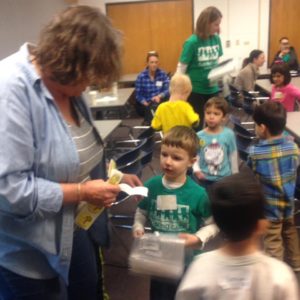 “Caring Cubs plans events where the children themselves can participate in a hands-on activity, taking personal pride in working toward a greater purpose. We partnered with Veggie U for a service project that fully engaged families with children ages 2 and up. Kids enjoyed the process of labeling bags-for some this involved letter and shape recognition, as well as sorting. On top of discussing the science of garden-to-table, families also were able to see the preparation that goes into classroom resources. This was a highly successful project that fully engaged those in attendance! We are excited to do it again!” -Shari Nacson, Caring Cubs
“Caring Cubs plans events where the children themselves can participate in a hands-on activity, taking personal pride in working toward a greater purpose. We partnered with Veggie U for a service project that fully engaged families with children ages 2 and up. Kids enjoyed the process of labeling bags-for some this involved letter and shape recognition, as well as sorting. On top of discussing the science of garden-to-table, families also were able to see the preparation that goes into classroom resources. This was a highly successful project that fully engaged those in attendance! We are excited to do it again!” -Shari Nacson, Caring Cubs
“Our connection with Caring Cubs through with Early Ages Healthy Stages Coalition, led to a successful service project in February, 2017. Caring Cubs met us at the Library and set to the task of labeling bags that Veggie U volunteers will later fill with soil samples. These samples are part of our classroom garden educational program and will help demonstrate why soil health is important to growing healthy vegetables for kids to eat! The families from Caring Cubs were such hard workers that they took care of 500 gardens! It was so amazing to see these families really get involved in making a difference. We are so grateful for their help!” -Susan Fain, Veggie U
Active Play Working Group:
Co-Facilitators: Kaylin Schaefer, Ohio Guidestone
Social Emotional Health Strategic Planning Handouts:
Sources:
Bierman, K. M. (2017). Parent Engagement Practices Improve Outcomes for Preschool Children. State College, Pennsylvania: Edna Bennett Pierce Prevention Research Center, Pennsylvania State University.
CDC, C. f. (2016, June March 9, 2017). About the CDC-Kaiser ACE Study. Retrieved from Violence Prevention: https://www.cdc.gov/violenceprevention/acestudy/about.html
Children, H. C. (2010). Adressing Childhood Obesity: A Priority for Ohio’s Business Community. Retrieved from Healthy Choices for Healthy Children: www.healthychoiceshealthychildren.org/index.php/resources
Collins, R. (2003). Promoting Mental Health in Chils Care Settings: Caring for the Whole Child. Zero to Three, 4, 39-45.
Consultation, C. f. (n.d.). Linking Families to Resources. Retrieved from Georgetown University Center for Child and Human Development: https://www.ecmhc.org/tutorials/trauma/mod4_5.html
Cook, A., PhD, Spinazzola, J., PhD, Ford, J., PhD, Lanktree, C., PhD, Cloitre, M., PhD, DeRosa, R., PhD, . . . Van Der Kolk, B., MD. (2005). Complex Trauma in Children and Adolescents. Psychiatric Annals; Thorofare, 35(5), 390-398. Retrieved June 20, 2017, from https://search.proquest.com/docview/217061735?accountid=9920
CPST, C. P. (2013, September March 9, 2017). Early Childhood Home Visitation to Prevent Child Mistreatment. Retrieved from Community Preventive Services Task Force: https://www.thecommunityguide.org/sites/default/files/assets/Violence-Early-Home-Vistation-Child-Maltreatment_0.pdf
CSSP, T. C. (2017). Protective Factors Framework. Retrieved from The Center for The Study of Social Policy: http://www.cssp.org/reform/strengtheningfamilies/about#protective-factors-framework
Families, T. I. (2017). Our Programs. Retrieved from The Health Federation of Philadelphia: http://www.instituteforsafefamilies.org/programs#edu
Garbarino, J. K. (1992). Child Maltreatment as a Community Problem. Child Abuse and Neglect, 16, 455-464.
High, A. T. (2015, February March, 9, 2017). ACES Science 101. Retrieved from ACES Too High: https://acestoohigh.com/aces-101/
HIP-Cuyahoga, H. I. (2013, March March 1, 2017). Community Health Status Assessment for Cuyahoga County, OH. Retrieved from Health Improvement Partnership of Cuyahoga County: http://www.naccho.org/uploads/downloadable-resources/Full-CHACHIPCombined-3-20-13.pdf
Merz, E. L. (2012). Associations among parental education, home environment quality, effortful control, and preacademic knowledge. Journal of Applied Developmental Psychology, 35, 305-315.
Miller–Heyl, Janet L., David MacPhee, and Janet J. Fritz. 2001. DARE to Be You: A Systems Approach to the Early Prevention of Problem Behaviors. New York, N.Y.: Kluwer Academic/Plenum Publishers
